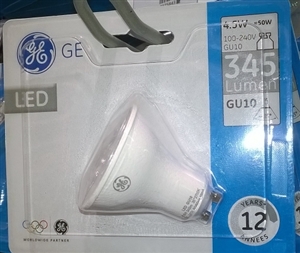

- The LED lamp claims light output 345 lumens.
- The LED lamp claims equivalent to 50 W halogen.
- The 50 W halogen lamp claims 680 lumens.
Clearly these three statements cannot all be true simultaneously. What is the typical customer supposed to make of this contradiction? Which statement is true and which is false? I believe the second statement is false, but then I am an engineer.
I do not wish to single out GE; other manufacturers are making similar claims. In fairness to GE, at least it is displaying on its packaging the output in lumens more prominently than anything else, in line with consumer recommendations. Some manufacturers display the equivalent wattage of older style halogen or GLS lamps more prominently than anything else. This is a practice that I deprecate; it is counter-educational and pays no regard to the not-too-distant future, when tungsten lamps will be all but forgotten.
So by what criteria can I make a judgement? I do not have access to an integrating sphere, where I can test these lamps individually for light output. Ideally I would look towards industry and official international standards for specified light output. But LED lamps are still a developing technology; it is not likely that any firm standards have yet been established. I believe that there are official standards for halogen lamps, including MR16 style, but access to these is not easy for me, now that I am no longer in service. It seems I would need to shell out a three-figure sum to purchase a book of as many pages, just to consult a table which probably occupies less than one page. I'm not prepared to do this.
One standard I do know about, however, is BS161 for tungsten filament GLS lamps. This is an obsolete standard, last revised around 1957, I presume then to incorporate coiled coil lamps, which were beginning to penetrate the market. According to that standard, a 60 W pearl lamp gives 665 lumens. Given that halogen lamps are more efficient than ordinary tungsten, it is reasonable to presume that if a 60 W lamp could give this much light all those years ago, the a 50 W halogen can give something similar. This seems to support the 50 W halogen claim of 680 lumens.
Let's look at the situation around 30 years ago. Compact source fluorescent lamps (CSF) were on the market as plug-in replacements for GLS tungsten lamps. Performance of these new lamps was sometimes over-claimed, e.g. 11 W low-energy lamp equivalent to 60 W tungsten, when in fact the 11 W CSF lamp delivered only around 500 lumens. This was the cause of some discontent among consumers and low-energy lamps received a bad press. Nowadays the claims of LED GLS replacements offer good value - 800 lumens as equivalent to 60 W tungsten; in fact this is more like 75 W tungsten. So why are the MR16 LED lamps over-claiming?
Can anyone suggest how this claim of MR16 LED lamp equivalent to 50 W halogen can be justified? Can anyone point to an official standard that will clarify the issue? If I have missed some vital point, I don't think I am the only one.